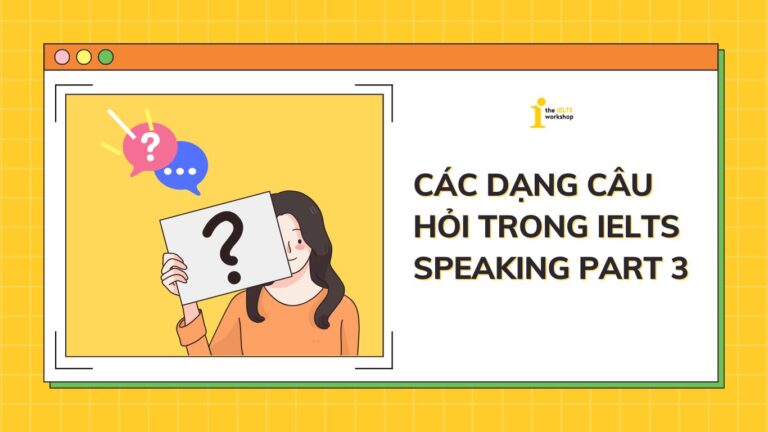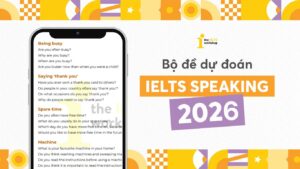Trong phần thi IELTS Speaking Part 3, thí sinh phải trả lời một lượng lớn những câu hỏi có liên quan tới chủ đề từ Part 2 trước. Nếu các bạn nắm được cấu trúc các dạng câu hỏi Part 3 một cách bài bản và sử dụng những dạng câu phù hợp thì chúng ta hoàn toàn có thể chinh phục được phần thi này. Trong bài viết ngày hôm nay, hãy cùng thầy Khánh Nam của The IELTS Workshop điểm qua các dạng câu hỏi trong IELTS Speaking Part 3 cũng như những cách trả lời cho mỗi dạng nhé.
1. Dạng câu hỏi Opinion (Ý kiến/quan điểm)
Ví dụ: Do you think modern technology makes people lazier?
Dạng câu hỏi Ý kiến (Opinion) là một dạng câu hỏi phổ biến trong phần thi Speaking Part 3. Dạng câu hỏi này tuy dễ để thí sinh nhận biết nhưng cũng đồng thời khó để trả lời một cách đa dạng do các bạn khi đi thi thường có thói quen mở đầu những câu hỏi này với các cụm từ quen thuộc như “I think…” hay “In my opinion”.
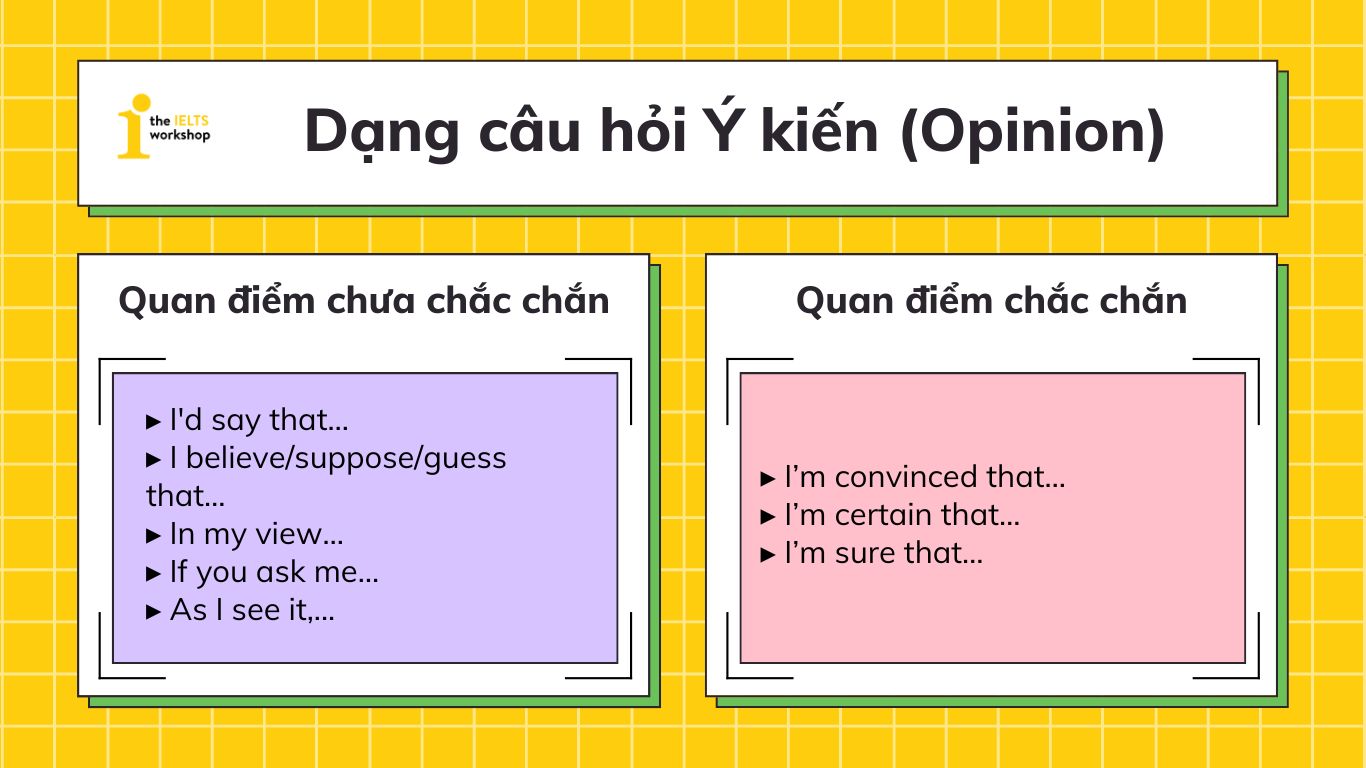
Thay vào đó, hãy sử dụng linh hoạt các cụm từ để tránh việc lặp lại những mẫu câu đơn giản.
Một số cách dẫn tham khảo:
▸ I’d say that…
▸ I believe/suppose/guess that…
▸ In my view…
▸ If you ask me…
▸ As I see it,…
Trong trường hợp bạn khá chắc chắn về câu trả lời và quan điểm của mình:
▸ I’m convinced that…
▸ I’m certain that…
▸ I’m sure that…
Example: Do you think that children should be forced to wear uniforms to school?
If you ask me, pupils of all ages should wear the same clothes when they study at school. It is necessary for giving children a sense of unity as youngsters need to deter from the consideration of wearing fashionable clothes as being superior in any way. If all students have to wear uniforms and see one another as equal, socially deprived children will not be picked on and discriminated against by those who come from richer families.
2. Dạng câu hỏi Evaluate (Đánh giá)
Ví dụ: Why do you think teenagers always want to have the latest devices?
Dạng câu hỏi Đánh giá (Evaluate) cũng tương tự với câu hỏi quan điểm cá nhân nhưng thí sinh lúc này sẽ phải trả lời cụ thể hơn dựa trên một đánh giá nhất định. Từ đó, việc nêu lên nhận định của mình về một trường hợp nào đó có thể được phân loại thành Agree hoặc Disagree.
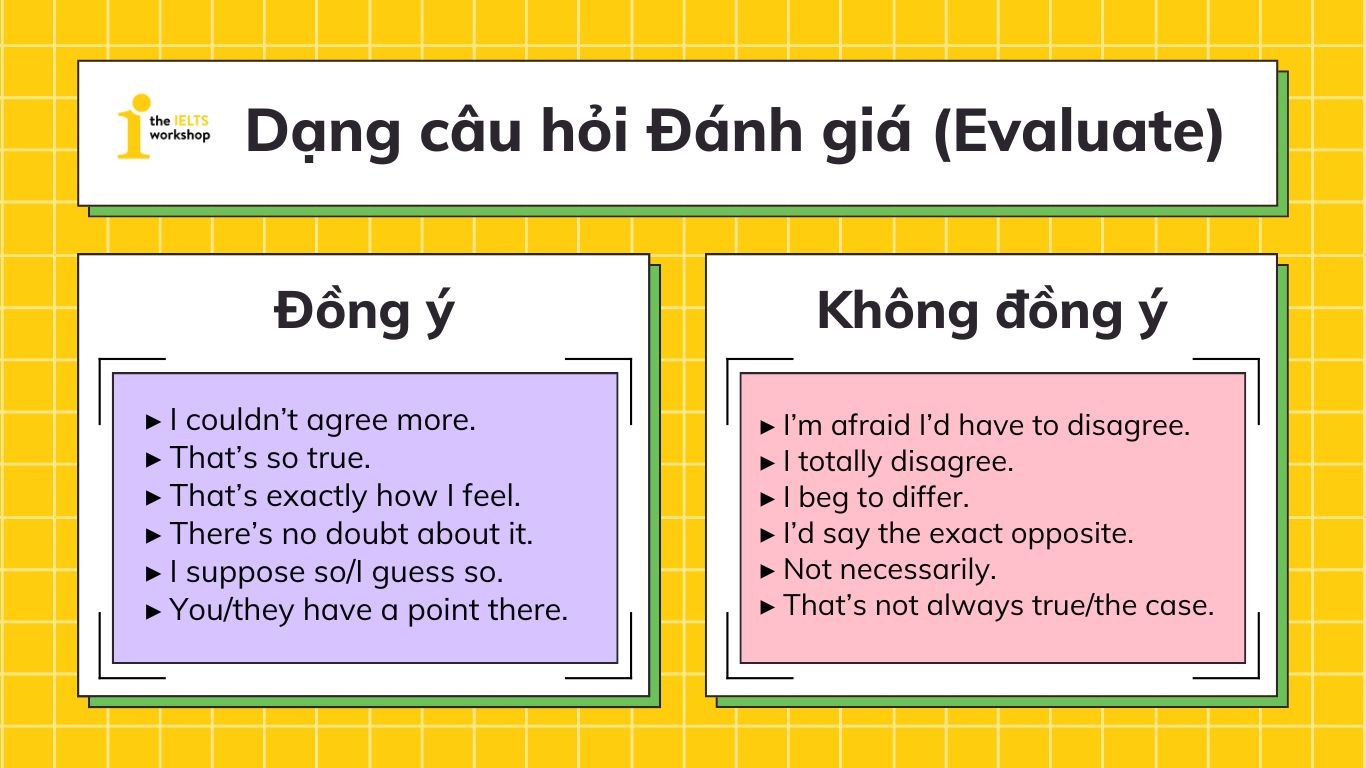
Nếu bạn đồng ý với quan điểm được đưa ra, bạn có thể dùng các cách biểu đạt sau để trả lời:
▸ I couldn’t agree more.
▸ That’s so true.
▸ That’s exactly how I feel.
▸ There’s no doubt about it.
▸ I suppose so/I guess so.
▸ You/they have a point there.
Trong trường hợp nếu bạn không đồng tình với câu hỏi đề bài:
▸ I’m afraid I’d have to disagree.
▸ I totally disagree.
▸ I beg to differ.
▸ I’d say the exact opposite.
▸ Not necessarily.
▸ That’s not always true/the case.
Câu mẫu: Some people say that people helped others more in the past than they do now. Do you agree or disagree?
That’s not always the case. When it comes to the older generation, they supported one another in the community as they empathized with all the hardships that fellow Vietnamese had suffered during our colonialism period. However, my generation is also regularly doing things to improve the current situation as young people are now actively encouraged to help in the community, carrying out tasks such as volunteering for various environmental and charitable organizations.
3. Dạng câu hỏi Future (Tương lai)
Ví dụ: How do you think the family will change in the future?
Trong dạng câu hỏi Tương lai (Future) này, các thí sinh cần đưa ra những dự đoán về sự kiện, hiện tượng sẽ xảy ra trong tương lai. Và để hạn chế sử dụng những cấu trúc thì tương lai thông dụng như “will + Verb”, hãy dùng các cụm từ sau để cải thiện khả năng ngôn ngữ của mình:
▸ It is predicted/foreseeable that…
▸ It is likely that…
▸ It is probable that…
▸ I envisage/predict/foresee…
▸ There is a strong possibility that…
▸ Future conditionals – If + S + Verb, S + will + Verb…
Câu mẫu: Some people say that working from home will be quite common in the future. Do you agree?
It is foreseeable that more people will work remotely from home in the not-so-distant future. If the Internet remains prevalent as it is now and more programs allow people to work from home more easily, it is likely that more people will stay at home. And if you think about it, most people nowadays are so accustomed to the Covid-19 pandemic that physically present to do their jobs and meet each other face-to-face might have already been a thing of the past.
4. Dạng câu hỏi Cause and Effect (Nguyên nhân & kết quả)
Ví dụ: Do you think social media influences the way we think?
Dạng câu hỏi Nguyên nhân & Kết quả (Cause and Effect) được áp dụng không chỉ trong Speaking mà cả Writing để nói tác động và ảnh hưởng của một vấn đề cụ thể nào đó. Những cách biểu đạt sau đây cũng hữu ích cho bạn đọc cả cho việc cải thiện Writing.
▸ …because…
▸ …as a result….
▸ …resulted in…
▸ …as a consequence…
▸ …due to….
▸ …caused…
▸ …led to….
▸ …means that….
Example: How does advertising influence what people choose to buy?
Advertising certainly has a big influence on what people purchase and often leads to them always sticking with the same brand. For example, Vietnamese people always prefer Coca-Cola to Pepsi hence the flavor and this is due to all the adverts on TV and people just instinctively buy it as a result. I mean, that would explain why companies spend so much money on advertisements as it led to more sales.
Xem thêm: Hướng dẫn A – Z cách làm Cause and Effect Essay trong IELTS Writing
5. Dạng câu hỏi Hypothetical
Ví dụ: If you could influence or had the power to change the world with your writings what would you want to change?
Đây là câu hỏi về những tình huống không thực tế hoặc yêu cầu bạn tưởng tượng về một vấn đề. Nếu gặp phải dạng này trong phần thi IELTS Speaking Part 3, các bạn cần dùng các loại câu điều kiện với mệnh đề giả định “If”. Câu điều kiện loại 2 thông thường sẽ được sử dụng rộng rãi nhất:
If + Subject 1 + past simple, Subject 2 + would + verb
Ngoài ra, bạn cần lưu ý các loại câu điều kiện khác để sử dụng thật phù hợp và chính xác trong câu trả lời của mình.
Câu mẫu: If you could choose any country to live in, where would you choose?
If I could live in any country, I would probably choose Iceland. Apart from the great weather, I always find myself dreaming about living an idyllic life, overlooking all those wonderful landscapes along with the presence of the Northern Lights. If I could choose another country, it would have to be Italy, for the architecture, the culture and its fascinating history.
6. Dạng câu hỏi Compare and Contrast (So sánh)
Ví dụ: What are the differences between living in the city and the countryside?
Đây là dạng câu hỏi so sánh. Thí sinh khi trả lời dạng câu này sẽ được kiểm tra về khả năng phân biệt hoặc so sánh hai đối tượng, sự việc khác nhau. Ngoài việc sử dụng những từ và cụm từ so sánh hơn như “better, worse, more interesting”, hãy cố gắng sử dụng những cụm từ so sánh linh hoạt hơn trong phần trả lời của mình.
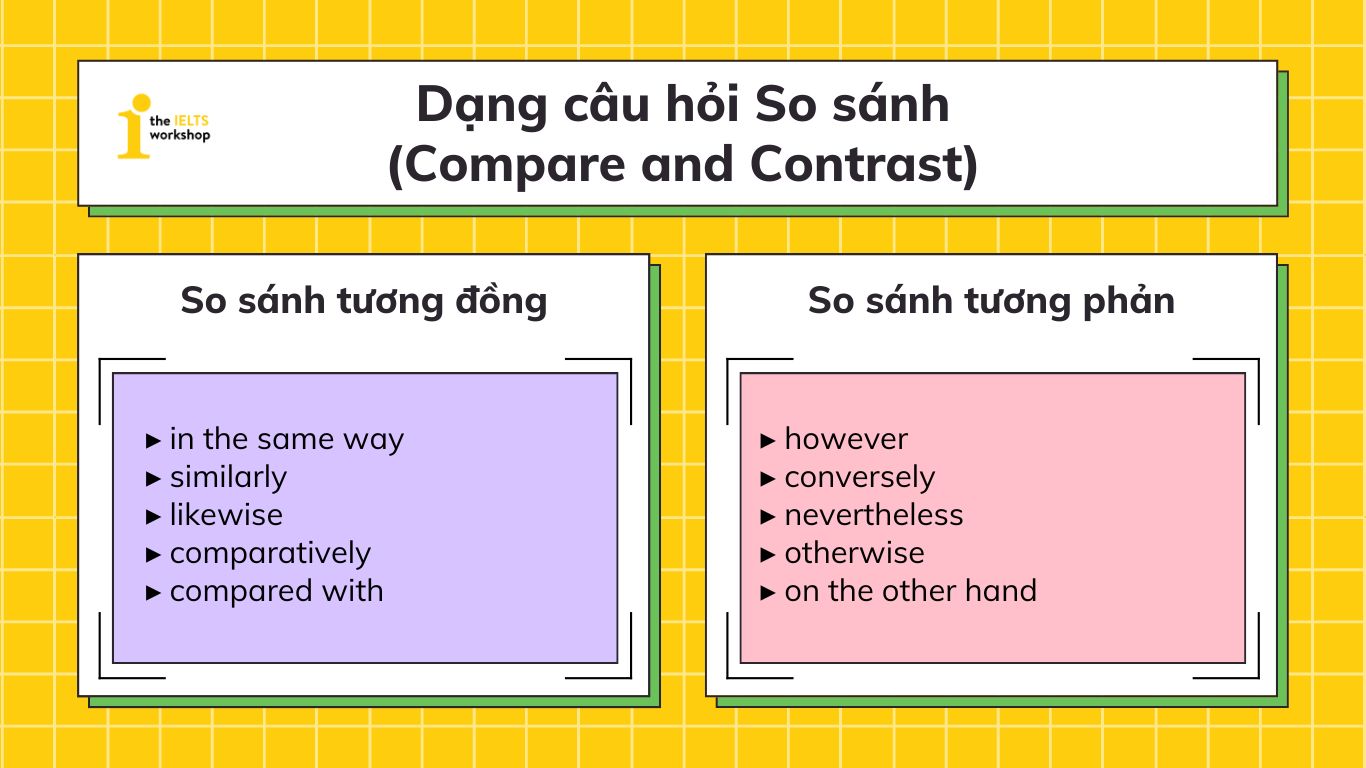
Khi câu hỏi yêu cầu bạn so sánh điểm tương đồng:
▸ in the same way
▸ similarly
▸ likewise
▸ comparatively
▸ compared with
Khi bạn muốn đưa ra các ý kiến tương phản:
▸ however
▸ conversely
▸ nevertheless
▸ otherwise
▸ on the other hand
Câu mẫu: Do you think primary school children should learn a second language or should they wait until secondary school?
It’s obvious that the earlier children start a foreign language the easier it becomes for them to be polyglots and open new opportunities later in life. However, some Vietnamese parents think that natural science subjects like math are more important than languages at the primary level as it helps enhance youngsters’ grades and academic profiles, which is of high priority in our country.
Xem thêm: Cách viết dạng bài Compare and Contrast trong IELTS Writing Task 2
7. Dạng câu hỏi Compare with the Past (So sánh với quá khứ)
Ví dụ: How has teaching changed in your country over the past few decades?
Để có thể trả lời dạng câu này một cách chính xác, thí sinh cần nêu lên sự thay đổi, trình bày sự giống và khác nhau của một việc xảy ra trong quá khứ so với hiện tại.
Các cấu trúc ngữ pháp khuyên dùng cho dạng câu hỏi này:
- Các thì quá khứ như past simple, past continuous và past perfect
- Thì present perfect (hiện tại hoàn thành) để nói về những sự việc đã bắt đầu ở quá khứ và tiếp diễn đến hiện tại.
Cấu trúc:
- have/has + past participle
- Used to + infinitive: Nói về một thói quen, hành động trong quá khứ mà nay không còn đúng hoặc tiếp diễn nữa.
Câu mẫu: How has teaching changed in your country over the past few decades?
In the past few decades, there have definitely been some noticeable changes in education through generations. Most notably, students today no longer corporal punishment from teachers, while in the past, that used to be fairly common. Another way that education has changed is teacher-student interaction. Today, it’s more normal to see students answering questions and having discussions, while in the past, the teacher simply lectured, and the students listened to facts silently.
Tác giả: Thầy Khánh Nam – Giáo viên tại The IELTS Workshop
Xem thêm:
- 5 cách trả lời IELTS Speaking Part 3 khi gặp câu hỏi khó
- Rèn luyện tư duy phản biện trong IELTS Speaking
Tạm kết
Với các dạng câu hỏi trong IELTS Speaking Part 3 và các cấu trúc hữu ích vừa rồi, hy vọng bạn đọc đã có góc nhìn tốt hơn về phần thi này cũng như trang bị cho bản thân những kiến thức bổ ích cho kỳ thi IELTS của mình. Đừng quên tham khảo thêm những cách luyện thi IETLS Speaking được gợi ý bởi TIW.
Ngoài ra, để có thể xác định được trình độ tiếng Anh của bản thân, bạn có thể làm bài TEST TRÌNH ĐỘ hoàn toàn miễn phí của The IELTS Workshop.
Nếu bạn đang gặp khó khăn chưa có phương pháp trả lời và diễn đạt cho các dạng câu hỏi trong IELTS Speaking Part 3, hãy tham khảo ngay lộ trình học tại khóa Senior của The IELTS Workshop.


